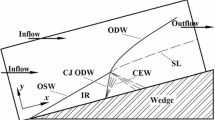Abstract
The flow field associated with a steady, planar, oblique detonation wave is discussed. A revision is provided forβ-θ diagrams, whereβ is the wave angle andθ is the ramp angle. A new solution is proposed for weak underdriven detonation waves that does not violate the second law. A Taylor wave, encountered in unsteady detonation waves, is required. Uniqueness and hysteresis effects are also discussed.
Similar content being viewed by others
References
Buckmaster J, Lee CJ (1990) Flow refraction by an uncoupled shock and reaction front. AIAA J 28:1310
Courant R, Friedricks KO (1948) Supersonic flow and shock waves. Interscience Pub., New York, Sect. HIE
Gross RA, Chinitz W (1960) A study of supersonic combustion. J Aerospace Sci 27:517–524, 534
Gross RA (1963) Oblique detonation waves. AIAA J 1:1225
Hertzberg A, Bruckner AP, Knowlen C (1991) Experimental investigation of ram accelerator propulsion modes. Shock Waves 1:17
Kistiakowsky GB, Kydd PH (1955) Gaseous detonations. VI. The rarefaction wave. J Chem Phys 23:271
Lasseigne DG, Hussaini MY (1993) Interaction of disturbances with an oblique detonation wave attached to a wedge. Phys Fluids A 5:1047
Menees GP, Adelman HG, Cambier JL, Bowles JV (1992) Wave combustors for trans-atmospheric vehicles. J Propulsion and Power 8:709
Ostrander MJ, Hyde JC, Young MF, Kissinger RD, Pratt DT (1987) Standing oblique detonation wave engine performance. AIAA Paper 87-2002
Powers JM, Gonthier KA (1992) Reaction zone structure for strong, weak overdriven, and weak underdriven oblique detonations. Phys Fluids A 4:2082
Powers JM, Stewart DS (1992) Approximate solutions for oblique detonations in the hypersonic limit. AIAA J 30:726
Pratt DT, Humphrey JW, Glenn DE (1987) Morphology of a standing oblique detonation wave. AIAA Paper 87-1785
Rubins PM, Cunningham THM (1965) Shock-induced supersonic combustion in a constant-area duct. J Spacecraft 2:199
Rubins PM, Rhodes Jr RP (1963) Shock-induced combustion with oblique shocks: comparison of experiment and kinetic calculations. AIAA J 1:2778
Taylor G (1950) The dynamics of the combustion products behind plane and spherical detonation fronts in explosives. Proc Roy Soc (Lond) A200:235
Yungster S, Eberhardt S, Bruckner AP (1991) Numerical simulation of hypervelocity projectiles in detonable gases. AIAA J 29:187
Author information
Authors and Affiliations
Additional information
This article was processed using Springer-Verlag TEX Shock Waves macro package 1.0 and the AMS fonts, developed by the American Mathematical Society.
Rights and permissions
About this article
Cite this article
Ashford, S.A., Emanuel, G. Wave angle for oblique detonation waves. Shock Waves 3, 327–329 (1994). https://doi.org/10.1007/BF01415831
Received:
Accepted:
Issue Date:
DOI: https://doi.org/10.1007/BF01415831




